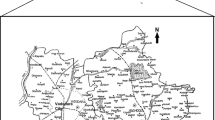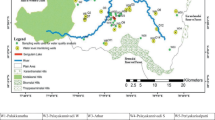Abstract
Analytical models, when used in stochastic analysis mode, may provide an effective tool for making informed management decisions for simplified environmental systems. This approach was used to evaluate migration of an organochlorine pesticide plume in a shallow, unconfined aquifer underlying a barrier island in coastal Georgia, USA. The contaminant plume at the site consists of four isomers of benzene hexachloride (BHC), also known as hexachlorocyclohexane (HCH). The deterministic analysis conducted at the site, which used calibrated, single-value input parameters, indicates that the contaminant plume will not reach wetlands that are downgradient of the source. Given the uncertainties involved in the deterministic analysis, this outcome was not considered to be sufficient to make effective management decisions at the site. Subsequently, probabilistic analysis using a range of input parameter values was conducted to estimate the risk that the pesticide plume would reach the downgradient wetlands. The two-stage Monte Carlo analysis that was conducted indicates the probability that contaminant levels will exceed the detection limit of BHC (0.044 micrograms per liter) at the wetlands increases from 1 percent to a maximum of 13 percent during the period 2005–2065. This represents an 87% or greater confidence level that the pesticide plume will not reach the wetlands. This outcome was used to inform environmental management decisions at the site. The modeling analysis was conducted using the publicly available analytical contaminant transport analysis system (ACTS) software.
Similar content being viewed by others
References
Aral MM (2010) Environmental modeling and health risk analysis (ACTS/RISK). Springer, Berlin, 510 pp
ATSDR [Agency for Toxic Substances and Disease Registry] (2005a) Health consultation for the Oatland Island Education Center, Savannah, Chatham County, GA. U.S. Department of Health and Human Services, Agency for Toxic Substances and Disease Registry, Atlanta, GA
ATSDR (2005b) Toxicological profile for hexachloro-cyclohexanes. U.S. Department of Health and Human Services, Agency for Toxic Substances and Disease Registry, Atlanta, GA
Anderson BA, Maslia ML, Caparoso JL, Ausdemore D (2007) Probabilistic analysis of pesticide transport in shallow groundwater at the Oatland Island Education Center, Oatland Island, Georgia. U.S. Department of Health and Human Services, Agency for Toxic Substances and Disease Registry, Atlanta, GA
Clarke JS, Hacke CM, Peck MF (1990) Geology and groundwater resources of the coastal area of Georgia. Georgia Department of Natural Resources, Georgia Geologic Survey, Bulletin 113, Atlanta, GA
Clayton G, Clayton F (eds) (1981) Patty’s industrial hygiene and toxicology, 3rd edn. Wiley, New York
Cullen AC, Frey HC (1999) Probabilistic techniques in exposure assessment: A handbook for dealing with variability and uncertainty in models and inputs. Plenum, New York
Domenico PA, Schwartz FW (1998) Physical and chemical hydrogeology. Wiley, New York
Environment Agency (2003) An illustrated handbook of DNAPL transport and fate in the subsurface. Environment Agency, R&D Publication 133, Bristol, UK
Fetter CW (1993) Contaminant hydrogeology. Macmillan, New York
Freeze R, Cherry J (1997) Groundwater. Prentice-Hall, Edgewood Cliffs
Gelhar LW, Welty C, Rehfeldt K (1992) A critical review of data on field-scale dispersion in aquifers. Water Resour Res 28(7):1955–1974
Georgia EPD [Georgia Environmental Protection Division] (1993) Hazardous site response. Chapter 391-3-19. In: Rules of Georgia Department of Natural Resources, Environmental Protection Division (last modified in June 2003), Atlanta, GA
Hollifield HC (1979) Rapid nephelometric estimate of water solubility of highly insoluble organic chemicals of environmental interest. Bull Environ Contam Toxicol 23:579–586
Hazardous Substances Data Bank (2003) Hexacyclochloro-hexanes. Environmental standards and regulations. National Institutes of Health, National Library of Medicine, Bethesda, MD. Available via http://toxnet.nlm.nih.gov/cgi-bin/sis/htmlgen?HSDB
Krause RE, Randolph RB (1989) Hydrology of the Floridan aquifer system in southeast Georgia and adjacent parts of Florida and South Carolina. U.S. Geological Survey, Professional Paper 1403-D, Denver, CO
Kurihara N, Uchida M, Fujita T et al. (1973) Studies on BHC isomers and related compounds: Some physiochemical properties of BHC isomers. Pestic Biochem Physiol 2:383–390
Mackay D, Shiu WY, Ma KC (1997) Illustrated handbook of physical-chemical properties and environmental fate for organic chemicals. CRC, Boca Raton
Maslia ML, Aral MM (2004) Analytical contaminant transport analysis system (ACTS)—Multimedia environmental fate and transport. Pract Period Hazard Toxic, Radiol Waste Manag 8(3):181–198
Maslia ML, Aral MM, Faye RE et al. (2009) Reconstructing historical exposures to volatile organic compound-contaminated drinking water at a U.S. military base. Water Qual Expo Health 1:49–68
Maslia ML, Aral MM, Williams RC (1997) Exposure assessment using analytical and numerical models: Case study. Pract Period Hazard, Toxic, Radiol Waste Manag 1(2):50–60
MWH [Montgomery Watson Harza] (2001) Final remediation report, Oatland Island Education Center, Oatland Island, Georgia. U.S. Department of Health and Human Services, Centers for Disease Control and Prevention, Atlanta, GA
MWH (2002a) Draft November 2001 round of semi-annual groundwater and monitored natural attenuation report, Oatland Island Education Center. U.S. Department of Health and Human Services, Centers for Disease Control and Prevention, Atlanta, GA
MWH (2002b) Draft July 2002 round of semi-annual groundwater and monitored natural attenuation report, Oatland Island Education Center. U.S. Department of Health and Human Services, Centers for Disease Control and Prevention, Atlanta, GA
MWH (2003) Final voluntary corrective action work plan in support of UIC permit application, Oatland Island Education Center. U.S. Department of Health and Human Services, Centers for Disease Control and Prevention, Atlanta, GA
MWH (2005) Final groundwater sampling and in situ chemical oxidation summary report, Oatland Island Education Center. U.S. Department of Health and Human Services, Centers for Disease Control and Prevention, Atlanta, GA
Morris DA, Johnson AI (1967) Summary of hydrologic and physical properties of rock and soil materials as analyzed by the Hydrologic Laboratory of the U.S. Geological Survey. U.S. Geological Survey, Water-Supply Paper 1839-D
Pankow JF, Cherry JA (1996) Dense chlorinated solvents and other DNAPLs in groundwater. Waterloo, Portland
Priest S (2004) Evaluation of groundwater contribution to streamflow in coastal Georgia and adjacent parts of Florida and South Carolina. U.S. Geological Survey, Scientific Investigations Report 2004-5265, Reston, VA
Ripping G (1972) Screening of the absorption behavior of new chemicals: Natural spoils and model absorptions. Ecotoxicol Environ Saf 6:236–245
Rodenbeck S, Maslia ML (1998) Groundwater modeling and GIS to determine exposure to TCE at Tucson. Pract Period Hazard, Toxic, Radiol Waste Manag 2(2):53–61
S&ME [Soil & Material Engineers, Inc] (1986) Groundwater availability of the Pliocene-recent aquifer system, Skidaway Island, Georgia. Soil and Material Engineers, Inc, Columbia, SC [unpublished report on file at the U.S. Geological Survey, Doraville, GA]
S&ME (1999) Environmental assessment report, areas “A” and “B, ” Oatland Island Education Center, Oatland Island, Georgia. U.S. Department of Health and Human Services, Centers for Disease Control and Prevention, Atlanta, GA
Schwille F (1988) Dense chlorinated solvents in porous and fractured media. CRC, Boca Raton
USDA [U.S. Department of Agriculture] (2004) Agricultural research service pesticide properties database. Available via http://www.ars.usda.gov/Services/docs.htm?docid=14199. Accessed April 2006
USEPA [U.S. Environmental Protection Agency] (1996) Soil screening guidance: Technical background document. U.S. Environmental Protection Agency, Superfund Program. Report No: EPA/540/R-96/018, Washington, DC
USEPA (2003) The DNAPL remediation challenge: Is there a case for source depletion? U.S. Environmental Protection Agency expert panel on DNAPL remediation. Report No.: EPA-600-R-03-143, Washington, DC
USEPA (2006a) Addendum to the 2002 Lindane Reregistration Eligibility Decision (RED). U.S. Environmental Protection Agency, Prevention, Pesticides and Toxic Substances. Report No: EPA 738-R-06-028, Washington, DC
USEPA (2006b) Assessment of lindane and other hexachlorocyclohexane isomers. U.S. Environmental Protection Agency, Prevention, Pesticides, and Toxic Substances. Washington, DC
USEPA (1993) Memorandum dated December 13 to Water Management Division Directors (USEPA Regions 1-10) from James R. Elder (Director) concerning guidance and clarification on the use of detection limits in compliance monitoring. U.S. Environmental Protection Agency, Office of Groundwater and Drinking Water, Washington, DC
Weiss G (ed) (1986) Hazardous chemicals data book. 2nd edn. Noyes Data Corporation, Park Ridge
Author information
Authors and Affiliations
Corresponding author
Additional information
Parts of the article were created within the capacity of a US governmental employment and therefore public domain. Published by Springer Science+Business Media B.V. 2010.
The findings and conclusions in this article are those of the authors and do not necessarily represent the views of the Agency for Toxic Substances and Disease Registry, the Centers for Disease Control and Prevention, or the U.S. Department of Health and Human Services.
Use of trade names and commercial sources is for identification only and does not imply endorsement by the funding agencies.
Rights and permissions
About this article
Cite this article
Anderson, B.A., Maslia, M.L., Caparoso, J.L. et al. Stochastic Analysis of Pesticide Transport in the Shallow Groundwater of Oatland Island, Georgia, USA. Water Qual Expo Health 2, 47–64 (2010). https://doi.org/10.1007/s12403-010-0023-6
Received:
Revised:
Accepted:
Published:
Issue Date:
DOI: https://doi.org/10.1007/s12403-010-0023-6




